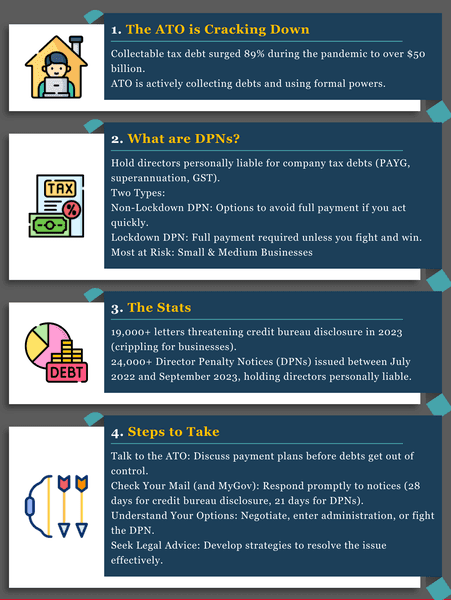During the dark days of the pandemic, the Australian Taxation Office put many debts on hold.
In that time collectable debt increased by 89% to more than $50 billion. The hold period has ended and the ATO is now in an aggressive debt collection phase, is seeking to change behaviours going forward, and is not afraid to use formal powers.
What does that look like? The statistics tell the story. More than:
- 19,000 letters notifying of intent to disclose tax debts to the credit bureaus issued in the 2023 financial year – an action that is crippling when taken; and
- 24,000 director penalty notices (DPNs) issued in the period from July 2022 to September 2023 holding directors personally responsible for corporate tax debts. The frequency is only increasing.
The reality is that small to medium businesses are most at risk for formal recovery actions as they are the most likely to experience material cash flow fluctuations triggering concern from the ATO as to solvency and liquidity. But no one is immune.

As much as it may feel like the easier option is ignoring the issue, letting lodgement obligations slip, allowing debt liabilities to increase, going quiet and hoping not to be noticed – sticking your head in the sand – is the worst thing you can do.
Overall, the key to getting the most optimal outcome possible for debt issues is proactive engagement.
Why? There are a number of reasons.
For the corporate entity the willingness of the ATO to negotiate manageable payment plans is enhanced by the conversation being initiated by the entity. Penalty exposures are also reduced where there is proactive engagement – that exposure being as much as 200 per cent of the primary amount owed in the case of superannuation debts and 100 per cent and denial of deductions for PAYG amounts.
But perhaps the most compelling reason is a director’s personal exposure. DPNs can be issued where a corporate entity has unpaid tax debts that are PAYG withholding amounts, superannuation guarantee charge amounts or GST liabilities. DPNs are a means to personally pursue directors for company tax debts. Directors of entities that have lodged on time but failed to pay have options other than paying the debt in full to avoid the personal liability. DPNs issued in these circumstances are known as “Non-Lockdown DPNs”. In contrast, directors of entities that have reported PAYG or GST debts more than three months late or superannuation guarantee charge debts more than one month late do not. Their only option to avoid personal liability is paying the debt in full. These DPN’s are known as “Lockdown DPNs”.
So, what steps can small-to-medium business directors take to protect themselves and their business when cash flow is tight, tax debts are accruing or one of these dreaded letters arrives?
1. Talk the talk
Prevention is always better than the cure.
Whilst formal recovery action can be taken in respect of tax debts the subject of a payment plan or agreement to defer it, it is much less likely to be. If you have a tax debt you can’t pay by the due date engage with the ATO to agree terms to pay it over time.
To enhance your prospects of negotiating a payment plan, it helps to have your financial records in order as they will be required for the negotiation– and are the last thing you want to be focusing on in times when cash flow is tight.
2. You have mail
The challenge for many lies in the fact that formal notices are usually dispatched via mail. If you haven’t maintained current address details with ASIC, you may not receive them at all – but will be deemed to have done so. The notices are also published on MyGov as well – but let’s be honest, most of us do not check that regularly.
3. Countdown starts now: your deadline for action
For a notice of intent to disclose to credit reporting bureaus there are only 28 days to respond. For a DPN that timeframe is just 21 days. If those timeframes are missed the options available to avoid and/or manage the exposure are greatly diminished – in most cases payment of the debt in full is the only remaining recourse.
4. Fight or fold: your move when a DPN strikes
Take the time to understand the type of DPN you’ve received and its implications.
Evaluate the company’s and directors’ financial standing and available options – negotiation for payment over a period of time may remain a viable option in some instances. In others, entering into administration or winding up is the better course. In some situations, fighting may be the only option.
Consider the defences available. The main defence is having taken reasonable steps to ensure the company’s compliance with its tax obligations and to show that the company was not insolvent during the relevant period. Bear in mind that the longer the period between receiving a notice and taking action, the less proactive engagement there has been with the ATO, the harder it is to establish these defences.
In weighing up your options, legal professionals can provide strategies tailored to your specific situation, increasing your chances of resolving the issue effectively.
Disclaimer
The information in this article is of a general nature and is not intended to address the circumstances of any particular individual or entity. Although we endeavour to provide accurate and timely information, we do not guarantee that the information in this article is accurate at the date it is received or that it will continue to be accurate in the future.
By Megan Bishop, Partner, Holding Redlich and Ross Hocking, Special Counsel Holding Redlich.
Keep up to date with our stories on LinkedIn, Twitter, Facebook and Instagram.


